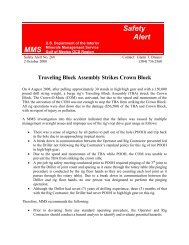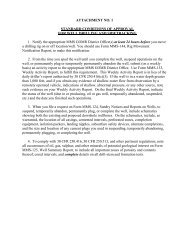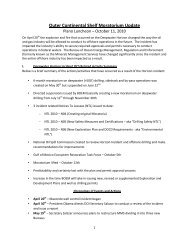Deepwater Gulf of Mexico 2004: America's Expanding ... - OCS BBS
Deepwater Gulf of Mexico 2004: America's Expanding ... - OCS BBS
Deepwater Gulf of Mexico 2004: America's Expanding ... - OCS BBS
- No tags were found...
You also want an ePaper? Increase the reach of your titles
YUMPU automatically turns print PDFs into web optimized ePapers that Google loves.
BACKGROUND<br />
DEFINITIONS<br />
The GOM Outer Continental Shelf (<strong>OCS</strong>) is divided into the Western, Central, and Eastern Planning<br />
Areas (figure 1). Many <strong>of</strong> the data presented in this report are subdivided according to water depth.<br />
These divisions (1,000, 1,500, 5,000, and 7,500 ft) are illustrated in figure 1, along with Deep Water<br />
Royalty Relief (DWRR) zones (200, 400, 800, and 1,600 m) for reference.<br />
There are a variety <strong>of</strong> criteria that can be used to define deepwater. The threshold separating shallow- and<br />
deepwater can range from 656-ft (200-m) to 1,500-ft (457-m) water depth. For purposes <strong>of</strong> this report,<br />
deepwater is defined as water depths greater than or equal to 1,000 ft (305 m). Similarly, ultra-deepwater<br />
is difficult to define precisely. For purposes <strong>of</strong> this report, ultra-deepwater is defined as water depths<br />
greater than or equal to 5,000 ft (1,524 m).<br />
A few other definitions are useful at this point:<br />
• Proved Reserves are those quantities <strong>of</strong> hydrocarbons that can be estimated with<br />
reasonable certainty to be commercially recoverable from known reservoirs. These<br />
reserves have been drilled and evaluated and are generally in a producing or soon-to-be<br />
producing field.<br />
• Unproved Reserves can be estimated with some certainty (drilled and evaluated) to be<br />
potentially recoverable, but there is as yet no commitment to develop the field.<br />
• Known Resources in this report refer to discovered resources (hydrocarbons whose<br />
location and quantity are known or estimated from specific geologic evidence) that have<br />
less geologic certainty and a lower probability <strong>of</strong> production than the Unproved Reserves<br />
category.<br />
• Industry-Announced Discoveries refer to oil and gas accumulations that were announced<br />
by a company or otherwise listed in industry publications. These discoveries have not<br />
been evaluated by MMS and the reliability <strong>of</strong> estimates can vary widely.<br />
• Field is defined as an area consisting <strong>of</strong> a single reservoir or multiple reservoirs all<br />
grouped on, or related to, the same general geologic structural feature and/or stratigraphic<br />
trapping condition. There may be two or more reservoirs in a field that are separated<br />
vertically by intervening impervious strata or laterally by local geologic barriers, or by<br />
both.<br />
More detailed definitions may be found in the annual Estimated Oil and Gas Reserves, <strong>Gulf</strong> <strong>of</strong> <strong>Mexico</strong><br />
Outer Continental Shelf, December 31, 2000 report (Crawford et al., 2003).<br />
This report refers to deepwater developments as both fields (as defined above) and by operator-designated<br />
project names. A field name is assigned to a lease or a group <strong>of</strong> leases so that natural gas and oil<br />
resources, reserves, and production can be allocated on the basis <strong>of</strong> the unique geologic feature that<br />
contains the hydrocarbon accumulation. Appendices A and B provide locations, operators, and additional<br />
information regarding these fields and projects. The field’s identifying block number corresponds to the<br />
first lease qualified by MMS as capable <strong>of</strong> production or the block where the primary structure is located.<br />
Note that the term “oil” refers to both oil and condensate throughout this report and “gas” includes both<br />
associated and nonassociated gas. All production volumes and rates reflect data through December 2002<br />
(the most recent, complete data available at the time <strong>of</strong> this publication).<br />
3







